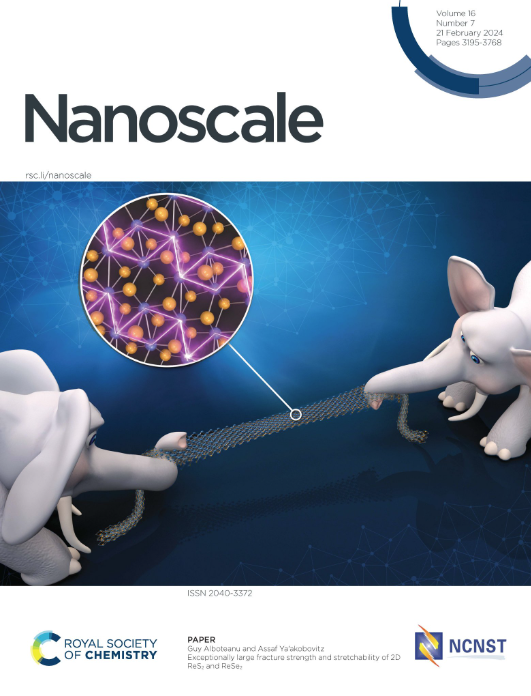Machine learning-guided fabrication of carbon dot-pepsin nano-conjugates for enhanced bioimaging, synergistic drug delivery, and visible light-induced photosensitization.
IF 5.8
3区 材料科学
Q1 CHEMISTRY, MULTIDISCIPLINARY
引用次数: 0
Abstract
Carbon dots (CDs) are emerging as next-generation bioimaging agents due to their strong fluorescence, photobleaching resistance, and biocompatibility. However, their small size often limits efficient cell internalization, leading to unspecified cellular targets and high endosomal escape. Herein, we showcase the potential of pepsin, a simple proteolytic enzyme, to address the limitations of CDs through its covalent conjugation and subsequent creation of CD-pepsin nanoparticles (NPs). Interestingly, repeated failures in achieving CD-pepsin NPs prompted us to explore machine learning (ML), which, in a novel approach, successfully predicted the most favourable conditions for their formation. These nanoparticles unlocked two critical functionalities beyond enhanced imaging: visible light-induced reactive oxygen species (ROS) generation and sustained drug delivery, highlighting their potential for chemo-photodynamic combination therapy. The photophysical properties of the green-emissive CDs, synthesized from 3-hydroxy-2-naphthoic acid, were significantly enhanced through covalent conjugation with pepsin. This enhancement was evident in the efficient confocal imaging of human macrophage cells (THP1 cells) using both the CD-pepsin covalent conjugate and CD-pepsin NPs. Beyond enhancing the imaging potential of CDs by stabilizing their surface states through covalent conjugation with pepsin, this modification also significantly increased ROS generation, surpassing conventional photosensitizers like protoporphyrin (PpIX). Irradiation of the cells with a simple 23 W white LED induced increased oxidative stress, leading to reduced cell viability. Simultaneously, the CD-pepsin NPs functioned as a drug delivery vehicle, enabling the sustained release of the model drug, doxorubicin, over 4-5 days. These combined functionalities-bioimaging, photosensitization, and drug delivery-highlight CD-pepsin NPs as a versatile and effective multipurpose platform, overcoming key limitations of pristine CDs for advanced theranostics.机器学习引导下碳点-胃蛋白酶纳米缀合物的制造,用于增强生物成像,协同药物传递和可见光诱导光敏化。
碳点(cd)由于其强大的荧光性、抗光漂白性和生物相容性,正在成为下一代生物显像剂。然而,它们的小尺寸往往限制了有效的细胞内化,导致未确定的细胞靶点和高内体逃逸。在此,我们展示了胃蛋白酶(一种简单的蛋白水解酶)的潜力,通过其共价偶联和随后的cd -胃蛋白酶纳米颗粒(NPs)的创建来解决cd的局限性。有趣的是,实现cd -胃蛋白酶NPs的多次失败促使我们探索机器学习(ML),它以一种新颖的方法成功地预测了它们形成的最有利条件。除了增强成像外,这些纳米颗粒解锁了两个关键功能:可见光诱导的活性氧(ROS)产生和持续的药物输送,突出了它们在化学-光动力联合治疗中的潜力。由3-羟基-2-萘酸合成的绿色发光CDs通过与胃蛋白酶的共价偶联,其光物理性能得到了显著提高。这种增强在使用cd -胃蛋白酶共价偶联物和cd -胃蛋白酶NPs对人巨噬细胞(THP1细胞)的有效共聚焦成像中是明显的。除了通过与胃蛋白酶的共价偶联来稳定CDs的表面状态以增强其成像潜力外,这种修饰还显著增加了ROS的产生,超过了传统的光敏剂如原卟啉(PpIX)。用简单的23w白光LED照射细胞诱导氧化应激增加,导致细胞活力降低。同时,cd -胃蛋白酶NPs作为药物递送载体,使模型药物阿霉素在4-5天内持续释放。这些综合功能-生物成像,光敏化和药物输送-突出了cd -胃蛋白酶NPs作为一个多功能和有效的多用途平台,克服了原始cd在高级治疗中的关键局限性。
本文章由计算机程序翻译,如有差异,请以英文原文为准。
求助全文
约1分钟内获得全文
求助全文
来源期刊

Nanoscale
CHEMISTRY, MULTIDISCIPLINARY-NANOSCIENCE & NANOTECHNOLOGY
CiteScore
12.10
自引率
3.00%
发文量
1628
审稿时长
1.6 months
期刊介绍:
Nanoscale is a high-impact international journal, publishing high-quality research across nanoscience and nanotechnology. Nanoscale publishes a full mix of research articles on experimental and theoretical work, including reviews, communications, and full papers.Highly interdisciplinary, this journal appeals to scientists, researchers and professionals interested in nanoscience and nanotechnology, quantum materials and quantum technology, including the areas of physics, chemistry, biology, medicine, materials, energy/environment, information technology, detection science, healthcare and drug discovery, and electronics.
 求助内容:
求助内容: 应助结果提醒方式:
应助结果提醒方式:


